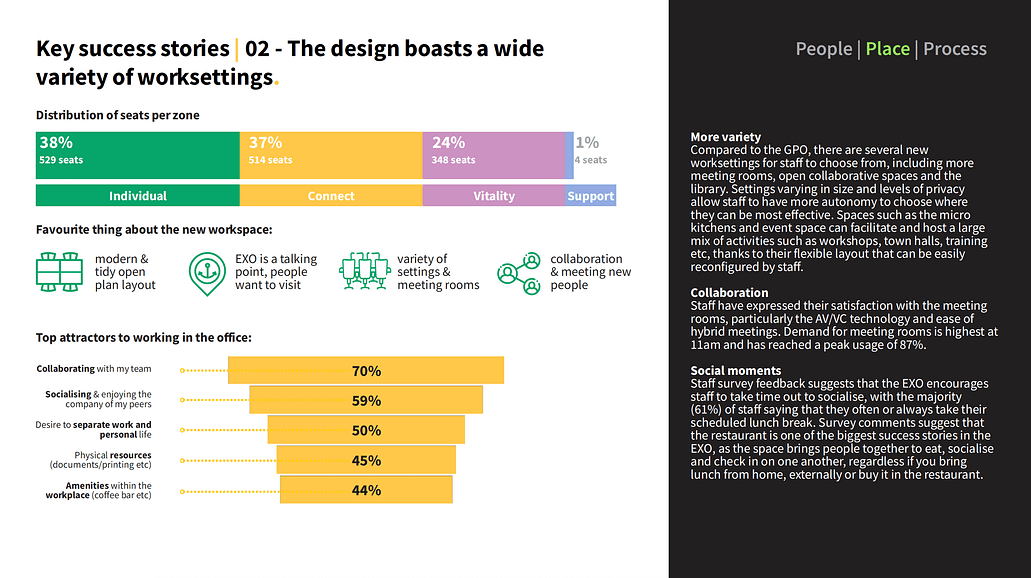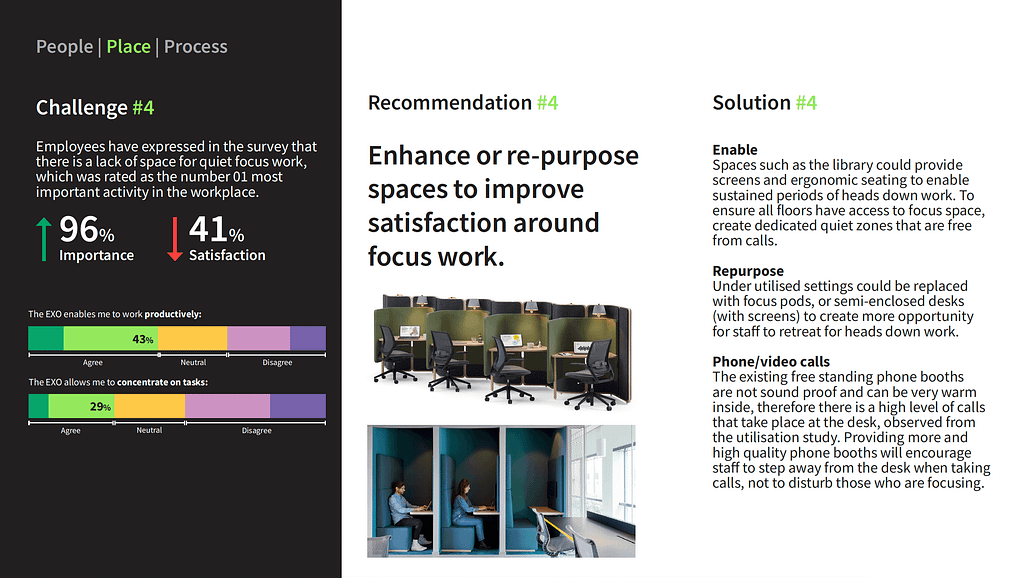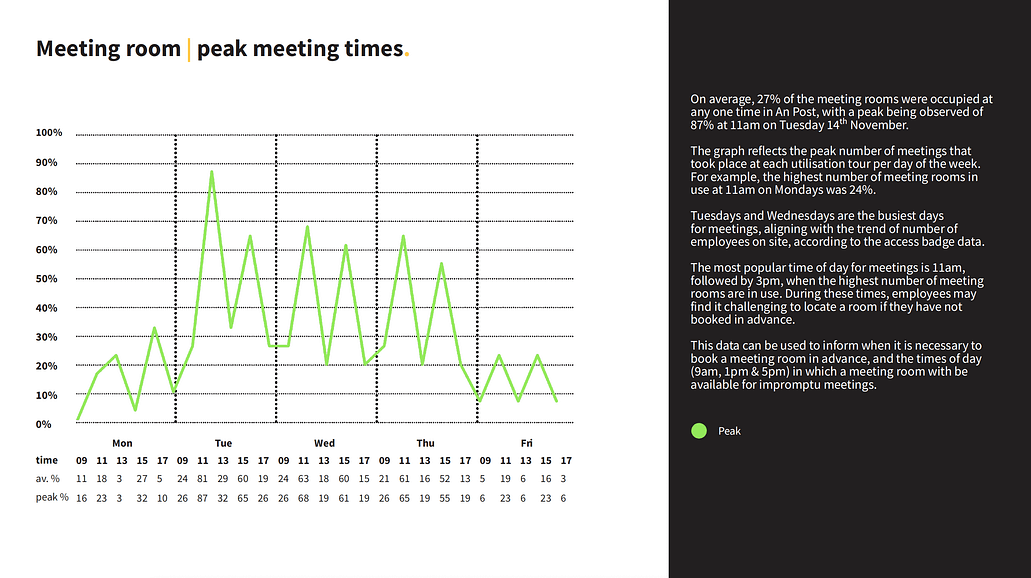Post-Occupancy Dynamics
By Helena Keeling
Strategist
Post-Occupancy Dynamics
While pre-occupancy planning is a critical phase of any project, workplace strategizing need not end on Day One when employees begin using the new space. Many businesses, focused heavily on achieving a perfect launch, overlook the importance of learning from a design’s performance as well as any gaps in employee satisfaction revealed during the first year of occupancy. Yet, a small investment in a Post-Occupancy Evaluation (POE) can uncover opportunities for improvement, ensuring the workplace’s long-term success while maximizing the value of the initial investment. Typically, a POE is a three-month process from engagement to reporting and should be undertaken no sooner than a year from completion.
In the current business landscape, the impact of a POE on designing workspaces that attract the workforce could not be more relevant. Although trends show organizations are continuing to make huge investments in their workplaces, occupancy data suggests office spaces remain underutilized. On average, the European office occupancy rate sits at 60%, still 10% lower than the pre-pandemic average of 70%. In January of this year, the US office occupancy rate was at 55.22% as opposed to approximately 88% pre-pandemic.
As a tool for assessing how a workplace performs after the initial excitement has subsided and day-to-day habits and routines are established, the POE helps organizations make sure their spaces continue to evolve in alignment with business goals and employee well-being. This is significant because of the direct correlation between staff satisfaction, engagement, and the cost of doing business—underlined by the 3-30-300 Rule stating that companies on average spend $3 on utilities, $30 on rent, and $300 on payroll per square foot per year. Designing for employee routines, rituals, and needs to achieve higher satisfaction rates will inspire increased engagement, greater production, and less turnover.
The POE process collects feedback on space usage, employee satisfaction, and operational activities to understand if the workplace is meeting its intended purpose. It identifies what is working well and areas for enhancement. A POE is not the only approach for capturing a list of needed improvements, but it is a proven way to gather evidence highlighting a project’s success (exemplified below) while demonstrating to staff that the organization is committed and cares that their experience at work is positive.

A recent case study based on a POE conducted for a confidential client in Dublin was the final piece of a strategic engagement that followed their transformative move from an iconic historical building in the heart of the city to a modern building at the docklands. The program consisted of:
Space Utilization Study: The results showed that on average 46% of workstations were occupied at any one time, with a peak of 76%. However, in certain workplace neighborhoods, the average was much higher with all desks occupied at times, meaning some team members had to work away from their colleagues, contrary to their intention when choosing to work in the office. Recommendations to the client included an assessment of the neighbourhood strategy, with proposed solutions such as re-assigning the zones based on occupancy data.

Ethnographic Study: Overall, the workplace earned a high score for natural light, brand identity, and fit for purpose. However, accessibility was the category showing the most opportunity for improvement, particularly in supporting neurodiverse team members in large, open spaces.
Staff Survey: The sentiment of almost 400 survey responses indicated that the new workplace is more inspiring, healthier, and more enjoyable than the previous location. In terms of importance and satisfaction, individual focus work was the most important activity for 96% of staff, although just 41% were satisfied with how effectively they could concentrate on heads-down work in the new office. This finding drove a key recommendation as part of our final POE report.

Function Interviews/Focus Groups: Overall feedback from HR, Customer Services, Finance, and Technology groups, etc., was very positive, complimenting the new space as a place where they are proud to work that reflects a vision of their brand as a modern, commercial business. However, Wi-Fi connectivity when moving from workstations to more agile space types was a challenge shared by multiple groups.
Like the client in this case study, many organizations collect occupancy data from a POE as well as information from other data streams, but focus too heavily on isolated metrics without considering how the data ties together. Fortunately, our client asked us to capture and synthesize the findings into holistic insights and actionable recommendations for Day Two adjustments. As a result, we were able to identify early on why open collaboration spaces were not being utilized and determine ways to activate them for better use or re-purpose them to provide more focus/library-style settings. These changes reflect how employees choose to work, rather than the way the organization had intended them to work.
An analysis of meeting rooms versus utilization demand and room booking data showed that the perception of insufficient meeting rooms was only valid at peak times, for example, 11 AM on a Tuesday, when almost 90% of meeting rooms were occupied. Adjusting their planned meeting times, when possible, to 1 PM or 3 PM would give staff a much wider variety of meeting rooms to book.

A final report for the client highlighted key successes, areas for improvement, and recommended ways to show staff the company’s dedication to achieving an optimal workplace experience. The opportunities proposed in our report were not solely spatial improvements; some called for a technology review to enable seamless use across all space types. Comments were included on policies and behaviors currently in place that should be reviewed to create a clearer narrative for staff.
We note that for many of our clients, a POE leads to iterative improvements for portfolio-wide changes, with each site testing and measuring improvements and innovations to inform the other sites—while consistently communicating findings to staff, building awareness that their feedback impacts peers’ spaces as much as their own. By creating a culture of continuous assessment in a rapidly evolving work environment, a commitment to ongoing improvement is key to staying flexible and future-focused while avoiding costly mistakes.
To conclude, a POE is an investment in long-term success. It provides a reality check on design assumptions and highlights areas for improvement that will ensure spaces remain adaptable to changing needs. By embracing the insights outlined by a POE, an organization can create a workplace that is not only impressive on Day One but continues to inspire success for years to come, enabling a full realization of its potential ROI. In the current business economy, the fine-tuned workplace that empowers an organization to move forward optimally is invaluable.
Report examples extracted from An Post, a project led by IA's London Studio.

